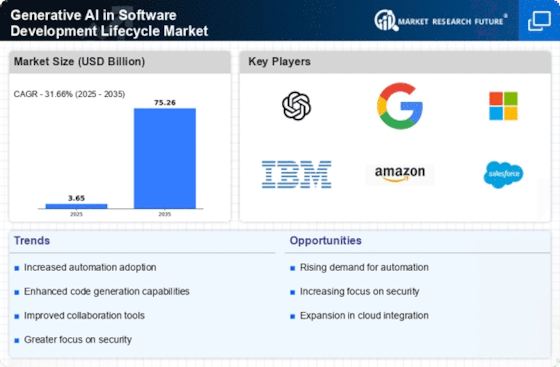Growing Emphasis on Quality Assurance
Quality assurance remains a critical focus within the Generative AI in Software Development Lifecycle Market. As software applications become more complex, the need for robust testing and validation processes has intensified. Generative AI technologies are being utilized to enhance testing methodologies, enabling automated generation of test cases and scenarios that cover a broader range of potential issues. This approach not only improves the accuracy of testing but also reduces the time spent on manual testing efforts. Market analysis indicates that organizations adopting AI-driven quality assurance practices can reduce defect rates by up to 30%. This trend underscores the importance of integrating generative AI into the software development lifecycle to ensure high-quality deliverables that meet user expectations and regulatory standards.
Integration of AI in DevOps Practices
The Generative AI in Software Development Lifecycle Market is increasingly influenced by the integration of artificial intelligence into DevOps practices. This integration facilitates continuous integration and continuous deployment (CI/CD) processes, which are crucial for modern software development. By leveraging generative AI, organizations can automate testing, monitoring, and deployment, significantly reducing the time required to bring software to market. Recent statistics suggest that companies employing AI-driven DevOps practices can achieve deployment frequencies that are 200 times higher than those using traditional methods. This capability not only enhances operational efficiency but also improves collaboration between development and operations teams, fostering a culture of innovation and rapid iteration. As the demand for faster and more reliable software delivery continues to rise, the role of generative AI in optimizing DevOps practices is likely to expand.
Increased Focus on Security and Compliance
Security and compliance are paramount concerns within the Generative AI in Software Development Lifecycle Market. As software systems become more interconnected, the potential for security vulnerabilities increases. Generative AI can play a pivotal role in identifying and mitigating these risks by automating security assessments and compliance checks throughout the development process. Recent findings indicate that organizations leveraging AI for security purposes can reduce the time spent on vulnerability assessments by up to 40%. This proactive approach to security not only protects sensitive data but also ensures adherence to regulatory requirements, which is increasingly critical in today's digital landscape. As the importance of security continues to grow, the integration of generative AI into the software development lifecycle is likely to become a standard practice.
Rising Demand for Efficient Development Tools
The Generative AI in Software Development Lifecycle Market is witnessing a surge in demand for tools that enhance efficiency and productivity. Organizations are increasingly seeking solutions that can automate repetitive tasks, thereby allowing developers to focus on more complex issues. According to recent data, the market for software development tools is projected to grow at a compound annual growth rate of approximately 25% over the next five years. This growth is driven by the need for faster delivery times and improved software quality. As companies strive to remain competitive, the integration of generative AI technologies into the software development lifecycle is becoming essential. This trend indicates a shift towards more intelligent systems that can adapt to changing requirements and streamline workflows, ultimately leading to a more agile development environment.
Shift Towards Agile Development Methodologies
The Generative AI in Software Development Lifecycle Market is experiencing a notable shift towards agile development methodologies. Agile practices emphasize flexibility, collaboration, and rapid iteration, which align well with the capabilities of generative AI. By incorporating AI-driven tools, teams can enhance their ability to respond to changing requirements and deliver incremental improvements. This adaptability is particularly valuable in fast-paced environments where customer needs evolve rapidly. Data suggests that organizations implementing agile methodologies alongside generative AI can achieve up to 50% faster time-to-market for new features. This synergy not only accelerates development cycles but also fosters a culture of continuous improvement and innovation, positioning companies to better meet the demands of their users.


















Leave a Comment